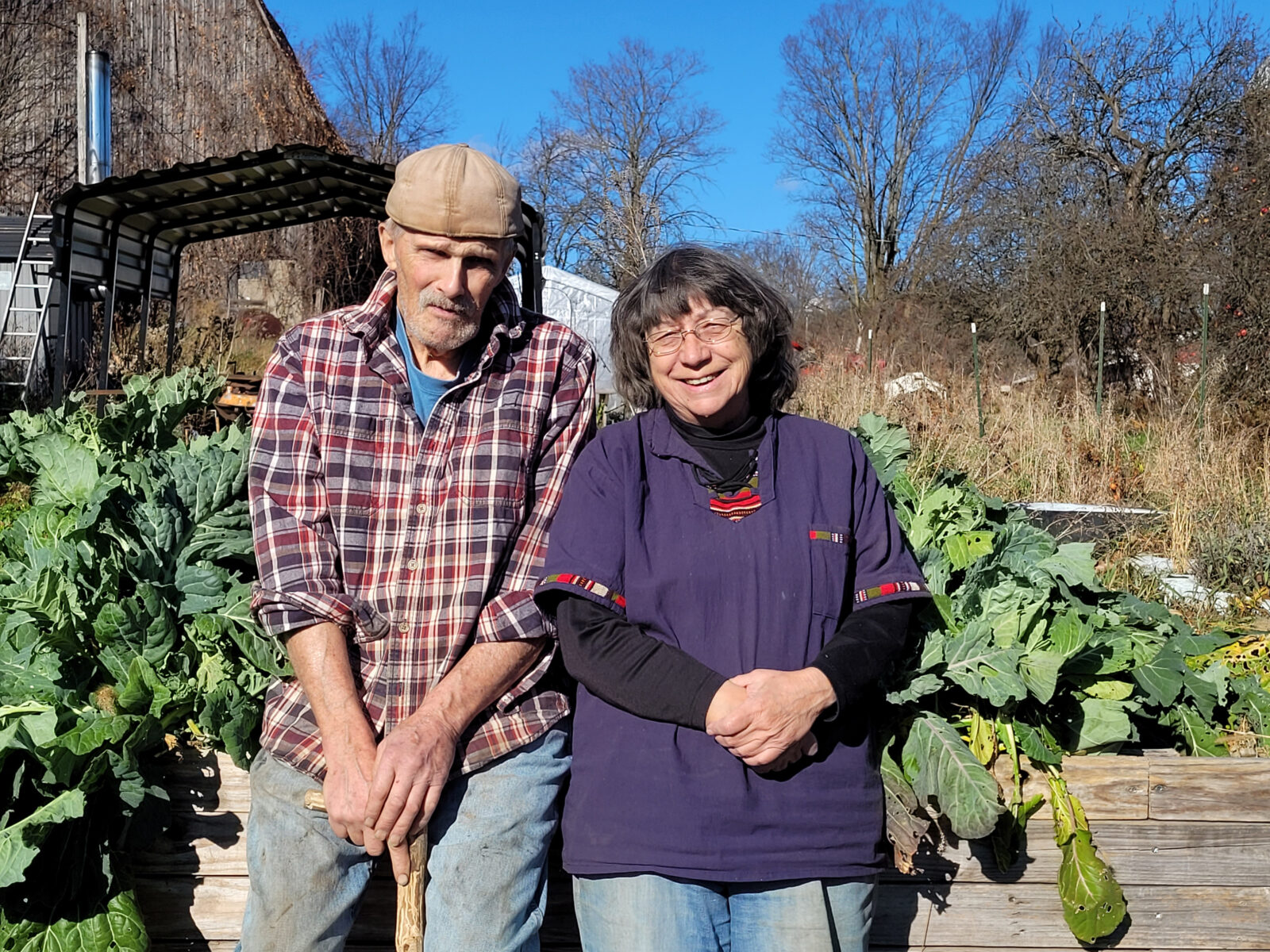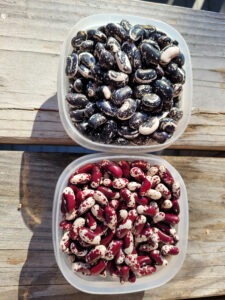Hope and Practice
To celebrate Seed Savers Exchange's 50th anniversary, we are featuring the work and inspiration of Exchange listers in the "Hope and Practice" series.

Kris Fox, Exchange lister, reflects on how she and her husband, Tom, first became involved in saving seeds and why they share seeds on the Exchange.
My fascination with seed diversity started when I saw a colorful display of dry beans in one of the seed catalogs I had requested. Some had maroon-and-white speckled coats. Some were deep-red. One was a tan-gold. Some were tan with brown lines. And one was white on one half and black on the other. The simple beauty of these beans struck me, and I decided I just had to grow some of them.
Both Tom (my husband) and I grew up in families that farmed and gardened, but no one saved seeds. The seeds were bought each winter and spring for that year’s garden. One of the seed catalogs, however, had guidelines for saving seeds, for not only beans but also each different type of vegetable. That’s how I got my start in saving seeds.
About the same time [2006], Tom and I discovered Seed Savers Exchange and immediately signed up as members. When our first Yearbook arrived, I was amazed at how many different varieties were listed. There were over 40 pages of bean listings, and over 150 pages of tomatoes of every type and color.

I read with great interest the “bios” of each individual “listing member” in the front of the Yearbook. The dedication these members had for saving rare and hard-to-find varieties was clear.
The concept of “orphan varieties” intrigued me. I wanted to grow something that literally no one else in America was growing except my source and me. It didn’t take me long to acquire a half-dozen such varieties. Most of these varieties I still grow today, and a few of them are still orphans. For example, I have never had a request for ‘Shield,’ a perfectly good yellow-eye bean that I acquired years ago.
Our favorite adoptee to date is a tomato variety I chose out of several pages of listings from the IPK Gene Bank. This collection was picked up from Germany by the Exchange in the 1990s, and the varieties didn’t have real names. Each was listed with a series of letters and numbers.
I picked “IPK T 1176” based on the brief description available. At first, this variety seemed like a poor choice. Only a few seeds germinated, and those plants seemed unhappy that whole first year. But I saved seeds from the few tomatoes we got, determined to give the variety every chance. The next year, I was so glad for the effort. Nearly every seed germinated; the plants thrived; and we got a bumper crop of Roma-type tomatoes. To this day, that variety is one of our two “must-grow” canning varieties.
While I had focused on beans, peppers, and lettuce in those early years, Tom turned special attention to tomatoes. He tests one or two new varieties most years, while still maintaining the dozens of varieties we have already accumulated. Several varieties have distinguished themselves and are grown every year. For canning, we favor ‘Legend’ (resistant to late blight) and IPKT 1176 (which we now call ‘Fox Legacy’ as a variety this nice deserves a name). Our favorite cherry tomatoes are ‘Yellow Peacevine’ and ‘Matt’s Wild Cherry.’ ‘New Yorker,’ ‘Old Brooks,’ ‘Nyagous,’ and many others do very well for us, too.
Reading the SSE Yearbook quickly became a favorite winter pastime for us (especially me!). The main downside to that was that I wanted to try almost every single variety I read about. So many choices, and so little time in one lifetime!
One day as I perused the pages of beans, I started noticing listings of varieties that originated with the Native American tribes. I knew about the history of the Iroquois Confederacy that used to predominate here in New York state. The Seneca Nation of the Iroquois were the people that lived right here in western New York, so I found and ordered a few varieties that originated with the Senecas and eagerly waited for spring so I could plant them. The vigor of these varieties, right from germination, surprised me. I thought maybe I was just lucky, but as I thought about it, it seemed more likely that after hundreds of years of being grown in the same region, these varieties were already highly adapted to our soil. I was hooked and gradually expanded the collection. I now grow about 15 Native American-sourced beans—mostly Iroquois, but also some Cherokee and other varieties.
Eventually, hoping to try different bean varieties, I planned to reduce my Native American collection. But demand for these varieties is so strong through the Exchange that I’ve kept growing them after all. I’ve been very pleased to send some of these seeds to Native Americans who are reconnecting with their cultural heritage. That just makes it seem so worthwhile!
Tom is the practical-minded one who grows the food we actually eat. Beets, potatoes, cucumbers, squash, and so on are in his part of the garden. With squash, we grow only one variety each of pepo, moschata, and maxima each year so that we have the option of saving seeds on any variety we really like. ‘Blue Hubbard’ is a favorite of Tom’s, although it is a space hog. ‘White Bush Scallop’ is a variety from which I like to save seeds.
We work hard at growing much of our own food, so part of our criteria for what to grow in our garden includes what yields food for our freezer and shelves. The big exception to that is me and my beans. With the exception of long rows of ‘Jacob’s Cattle’ and ‘Black Valentine’ beans, which we grow for dry beans and freezer green beans respectively, I grow smaller rows or patches of as many different varieties of beans as I can squeeze into the space designated as my “seed garden.” I intersperse them with lettuce, soybeans, some tomatoes, and so on, so they are spaced apart a little.
I set up a bamboo tripod for each variety of pole beans. I always grow ‘Seneca Allegany Pinto’ beans on my corn, because it only climbs to about five feet tall. Many pole beans will overwhelm corn and pull it over, especially my ‘Bear Paw’ popcorn, which isn’t very tall. By the way, that is the correct New York state spelling of Allegany. I once had a well-meaning member “correct” me that it should be Allegheny, as it is spelled in Pennsylvania.
Early in my seed-saving life, I struck up an online friendship with an older man who had a passion for peppers. He gave me lots of advice for growing peppers and shared pictures of his favorite varieties. I thought of him as a mentor, and then, one day he was gone. I don’t know if he died, or entered a nursing home, or what. I was sorry to lose him, and it taught me an important lesson. Like humans everywhere, the life of a seed saver is finite. Ever since then, I watch for older or possibly ailing members who need to find homes for some of their favorite varieties.
I am in my 60s now, and Tom is over 70, so we are becoming aware that we are no longer young. We expect to have a number of years of good health ahead of us, but we won’t live forever.
Our hope is that the seed-saving community remains robust, and that younger people keep joining in as older members gradually become unable to maintain as many seed varieties as we used to. If that happens, the work will continue long after we are gone, but we will have played our part for the span of a few decades.
Kris and Tom Fox of Avoca, New York, list 59 varieties in the 2025 Yearbook.
Hope and Practice
To celebrate Seed Savers Exchange's 50th anniversary, we are featuring the work and inspiration of Exchange listers in the "Hope and Practice" series.

This dual-purpose variety works well for making soup and growing tasty fresh snap beans.

This productive variety boasts an excellent, full flavor perfect for eating fresh, making sauce, or roasting.